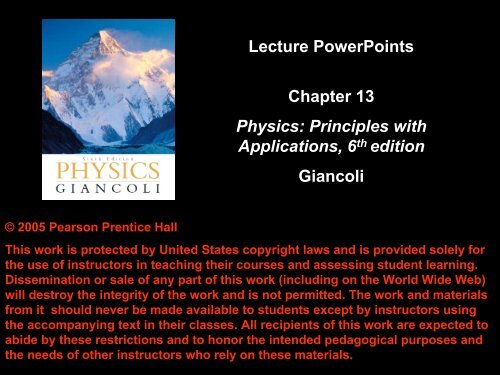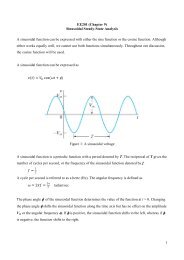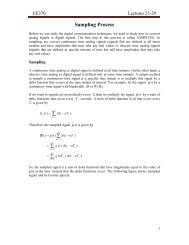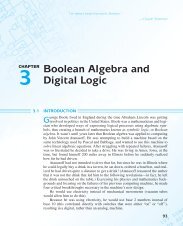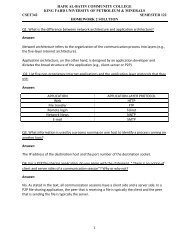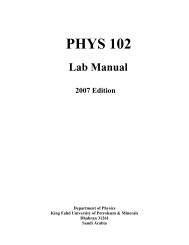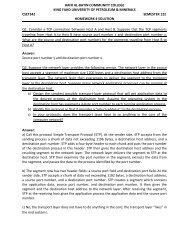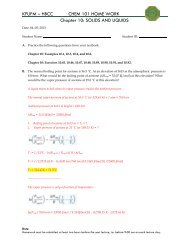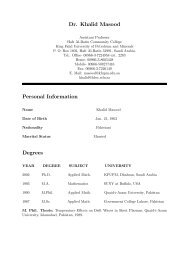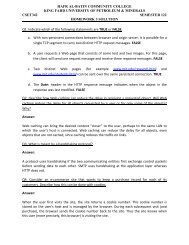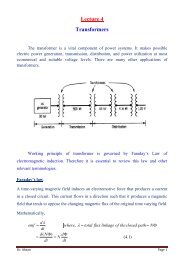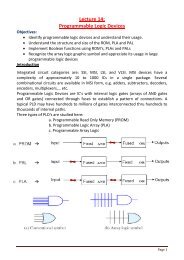Lecture PowerPoints Chapter 13 Physics: Principles with ...
Lecture PowerPoints Chapter 13 Physics: Principles with ...
Lecture PowerPoints Chapter 13 Physics: Principles with ...
You also want an ePaper? Increase the reach of your titles
YUMPU automatically turns print PDFs into web optimized ePapers that Google loves.
<strong>Lecture</strong> <strong>PowerPoints</strong><br />
<strong>Chapter</strong> <strong>13</strong><br />
<strong>Physics</strong>: <strong>Principles</strong> <strong>with</strong><br />
Applications, 6 th edition<br />
Giancoli<br />
© 2005 Pearson Prentice Hall<br />
This work is protected by United States copyright laws and is provided solely for<br />
the use of instructors in teaching their courses and assessing student learning.<br />
Dissemination or sale of any part of this work (including on the World Wide Web)<br />
will destroy the integrity of the work and is not permitted. The work and materials<br />
from it should never be made available to students except by instructors using<br />
the accompanying text in their classes. All recipients of this work are expected to<br />
abide by these restrictions and to honor the intended pedagogical purposes and<br />
the needs of other instructors who rely on these materials.
<strong>Chapter</strong> <strong>13</strong><br />
Temperature and Kinetic<br />
Theory
Units of <strong>Chapter</strong> <strong>13</strong><br />
•Atomic Theory of Matter<br />
•Temperature and Thermometers<br />
•Thermal Equilibrium and the Zeroth Law of<br />
Thermodynamics<br />
•Thermal Expansion<br />
•Thermal Stress<br />
•The Gas Laws and Absolute Temperature<br />
•The Ideal Gas Law
Units of <strong>Chapter</strong> <strong>13</strong><br />
•Problem Solving <strong>with</strong> the Ideal Gas Law<br />
•Ideal Gas Law in Terms of Molecules:<br />
Avogadro’s Number<br />
•Kinetic Theory and the Molecular Interpretation<br />
of Temperature<br />
•Distribution of Molecular Speeds<br />
•Real Gases and Changes of Phase<br />
•Vapor Pressure and Humidity<br />
•Diffusion
<strong>13</strong>-1 Atomic Theory of Matter<br />
Atomic and molecular masses are measured in<br />
unified atomic mass units (u). This unit is<br />
defined so that the carbon-12 atom has a mass<br />
of exactly 12.0000 u. Expressed in kilograms:<br />
Brownian motion is the jittery<br />
motion of tiny flecks in water;<br />
these are the result of<br />
collisions <strong>with</strong> individual water<br />
molecules.
<strong>13</strong>-1 Atomic Theory of Matter<br />
On a microscopic scale, the arrangements of<br />
molecules in solids (a), liquids (b), and gases (c)<br />
are quite different.
<strong>13</strong>-2 Temperature and Thermometers<br />
Temperature is a measure of how hot or cold<br />
something is.<br />
Most materials expand when heated.
<strong>13</strong>-2 Temperature and Thermometers<br />
Thermometers are instruments designed to<br />
measure temperature. In order to do this, they<br />
take advantage of some property of matter that<br />
changes <strong>with</strong> temperature.<br />
Early thermometers:
<strong>13</strong>-2 Temperature and Thermometers<br />
Common thermometers used today include the<br />
liquid-in-glass type and the bimetallic strip.
<strong>13</strong>-2 Temperature and Thermometers<br />
Temperature is generally<br />
measured using either the<br />
Fahrenheit or the Celsius<br />
scale.<br />
The freezing point of water is<br />
0°C, or 32°F; the boiling point<br />
of water is 100°C, or 212°F.
<strong>13</strong>-3 Thermal Equilibrium and the Zeroth<br />
Law of Thermodynamics<br />
Two objects placed in thermal contact will<br />
eventually come to the same temperature.<br />
When they do, we say they are in thermal<br />
equilibrium.<br />
The zeroth law of thermodynamics says that if<br />
two objects are each in equilibrium <strong>with</strong> a third<br />
object, they are also in thermal equilibrium <strong>with</strong><br />
each other.
<strong>13</strong>-4 Thermal Expansion<br />
Linear expansion<br />
occurs when an object<br />
is heated.<br />
(<strong>13</strong>-1b)<br />
Here, α is the coefficient of linear<br />
expansion.
<strong>13</strong>-4 Thermal Expansion<br />
Volume expansion is similar, except that it is<br />
relevant for liquids and gases as well as solids:<br />
(<strong>13</strong>-2)<br />
Here, β is the coefficient of volume<br />
expansion.<br />
For uniform solids,
<strong>13</strong>-4 Thermal Expansion
<strong>13</strong>-4 Thermal Expansion<br />
Water behaves differently from most other solids – its<br />
minimum volume occurs when its temperature is 4°C. As it<br />
cools further, it expands, as anyone who has left a bottle in<br />
the freezer to cool and then forgets about it can testify.
<strong>13</strong>-5 Thermal Stresses<br />
A material may be fixed at its ends and therefore be<br />
unable to expand when the temperature changes. It<br />
will then experience large compressive or tensile<br />
stress – thermal stress – when its temperature<br />
changes.<br />
The force required to keep the material from<br />
expanding is given by:<br />
where E is the Young’s modulus of the material.<br />
Therefore, the stress is:
<strong>13</strong>-6 The Gas Laws and Absolute Temperature<br />
The relationship between the volume, pressure,<br />
temperature, and mass of a gas is called an equation<br />
of state.<br />
We will deal here <strong>with</strong> gases that are not too dense.<br />
Boyle’s Law: the volume of a<br />
given amount of gas is inversely<br />
proportional to the pressure as<br />
long as the temperature is<br />
constant.
<strong>13</strong>-6 The Gas Laws and Absolute Temperature<br />
The volume is linearly proportional to the<br />
temperature, as long as the temperature is<br />
somewhat above the condensation point and<br />
the pressure is constant:<br />
Extrapolating, the volume becomes zero at<br />
−273.15°C; this temperature is called absolute<br />
zero.
<strong>13</strong>-6 The Gas Laws and Absolute Temperature<br />
The concept of absolute zero allows us to define<br />
a third temperature scale – the absolute, or<br />
Kelvin, scale.<br />
This scale starts <strong>with</strong> 0 K at absolute zero, but<br />
otherwise is the same as the Celsius scale.<br />
Therefore, the freezing point of water is<br />
273.15 K, and the boiling point is 373.15 K.<br />
Finally, when the volume is constant, the<br />
pressure is directly proportional to the<br />
temperature:
<strong>13</strong>-7 The Ideal Gas Law<br />
We can combine the three relations just<br />
derived into a single relation:<br />
What about the amount of gas present? If<br />
the temperature and pressure are constant,<br />
the volume is proportional to the amount of<br />
gas:
<strong>13</strong>-7 The Ideal Gas Law<br />
A mole (mol) is defined as the number of grams<br />
of a substance that is numerically equal to the<br />
molecular mass of the substance:<br />
1 mol H 2 has a mass of 2 g<br />
1 mol Ne has a mass of 20 g<br />
1 mol CO 2 has a mass of 44 g<br />
The number of moles in a certain mass of<br />
material:
<strong>13</strong>-7 The Ideal Gas Law<br />
We can now write the ideal gas law:<br />
(<strong>13</strong>-3)<br />
where n is the number of moles and<br />
R is the universal gas constant.
<strong>13</strong>-8 Problem Solving <strong>with</strong> the Ideal Gas Law<br />
Useful facts and definitions:<br />
• Standard temperature and pressure (STP)<br />
• Volume of 1 mol of an ideal gas is 22.4 L<br />
• If the amount of gas does not change:<br />
• Always measure T in kelvins<br />
• P must be the absolute pressure
<strong>13</strong>-9 Ideal Gas Law in Terms of Molecules:<br />
Avogadro’s Number<br />
Since the gas constant is universal, the<br />
number of molecules in one mole is the same<br />
for all gases. That number is called Avogadro’s<br />
number:<br />
The number of molecules in a gas is the<br />
number of moles times Avogadro’s number:
<strong>13</strong>-9 Ideal Gas Law in Terms of Molecules:<br />
Avogadro’s Number<br />
Therefore we can write:<br />
where k is called Boltzmann’s constant.<br />
(<strong>13</strong>-4)
<strong>13</strong>-10 Kinetic Theory and the Molecular<br />
Interpretation of Temperature<br />
Assumptions of kinetic theory:<br />
• large number of molecules, moving in random<br />
directions <strong>with</strong> a variety of speeds<br />
• molecules are far apart, on average<br />
• molecules obey laws of classical mechanics<br />
and interact only when colliding<br />
• collisions are perfectly elastic
<strong>13</strong>-10 Kinetic Theory and the Molecular<br />
Interpretation of Temperature<br />
The force exerted on the wall by<br />
the collision of one molecule is<br />
Then the force due to all<br />
molecules colliding <strong>with</strong> that<br />
wall is
<strong>13</strong>-10 Kinetic Theory and the Molecular<br />
Interpretation of Temperature<br />
The averages of the squares of the speeds in all<br />
three directions are equal:<br />
So the pressure is:<br />
(<strong>13</strong>-6)
<strong>13</strong>-10 Kinetic Theory and the Molecular<br />
Interpretation of Temperature<br />
Rewriting, (<strong>13</strong>-7)<br />
so<br />
(<strong>13</strong>-8)<br />
The average translational kinetic energy of<br />
the molecules in an ideal gas is directly<br />
proportional to the temperature of the gas.
<strong>13</strong>-10 Kinetic Theory and the Molecular<br />
Interpretation of Temperature<br />
We can invert this to find the average speed of<br />
molecules in a gas as a function of<br />
temperature:<br />
(<strong>13</strong>-9)
<strong>13</strong>-11 Distribution of Molecular Speeds<br />
These two graphs<br />
show the distribution<br />
of speeds of<br />
molecules in a gas, as<br />
derived by Maxwell.<br />
The most probable<br />
speed, v P , is not quite<br />
the same as the rms<br />
speed.<br />
As expected, the<br />
curves shift to the<br />
right <strong>with</strong> temperature.
<strong>13</strong>-12 Real Gases and Changes of Phase<br />
The curves here represent the<br />
behavior of the gas at different<br />
temperatures. The cooler it gets,<br />
the farther the gas is from ideal.<br />
In curve D, the gas becomes<br />
liquid; it begins condensing<br />
at (b) and is entirely liquid at<br />
(a).<br />
The point (c) is<br />
called the critical<br />
point.
<strong>13</strong>-12 Real Gases and Changes of Phase<br />
Below the critical temperature, the gas can<br />
liquefy if the pressure is sufficient; above it, no<br />
amount of pressure will suffice.
<strong>13</strong>-12 Real Gases and Changes of Phase<br />
A PT diagram is called a phase diagram; it<br />
shows all three phases of matter. The solidliquid<br />
transition is melting or freezing; the<br />
liquid-vapor one is boiling or condensing; and<br />
the solid-vapor one is sublimation.<br />
Phase diagram of<br />
water
<strong>13</strong>-12 Real Gases and Changes of Phase<br />
The triple point is the only point where all three<br />
phases can coexist in equilibrium.<br />
Phase diagram of<br />
carbon dioxide
<strong>13</strong>-<strong>13</strong> Vapor Pressure and Humidity<br />
An open container of water can<br />
evaporate, rather than boil, away.<br />
The fastest molecules are escaping<br />
from the water’s surface, so<br />
evaporation is a cooling process as<br />
well.<br />
The inverse process is called<br />
condensation.<br />
When the evaporation and<br />
condensation processes are in<br />
equilibrium, the vapor just above the<br />
liquid is said to be saturated, and its<br />
pressure is the saturated vapor<br />
pressure.
<strong>13</strong>-<strong>13</strong> Vapor Pressure and<br />
Humidity<br />
The saturated vapor<br />
pressure increases <strong>with</strong><br />
temperature.
<strong>13</strong>-<strong>13</strong> Vapor Pressure and Humidity<br />
A liquid boils when<br />
its saturated vapor<br />
pressure equals the<br />
external pressure.
<strong>13</strong>-<strong>13</strong> Vapor Pressure and Humidity<br />
Partial pressure is the pressure each<br />
component of a mixture of gases would exert if<br />
it were the only gas present. The partial<br />
pressure of water in the air can be as low as<br />
zero, and as high as the saturated vapor<br />
pressure at that temperature.<br />
Relative humidity is a measure of the saturation<br />
of the air.
<strong>13</strong>-<strong>13</strong> Vapor Pressure and Humidity<br />
When the humidity is high, it feels muggy; it is<br />
hard for any more water to evaporate.<br />
The dew point is the<br />
temperature at which the air<br />
would be saturated <strong>with</strong><br />
water.<br />
If the temperature goes<br />
below the dew point, dew,<br />
fog, or even rain may occur.
<strong>13</strong>-14 Diffusion<br />
Even <strong>with</strong>out stirring, a few drops of dye in water<br />
will gradually spread throughout. This process is<br />
called diffusion.
<strong>13</strong>-14 Diffusion<br />
Diffusion occurs from a region of high<br />
concentration towards a region of lower<br />
concentration.
<strong>13</strong>-14 Diffusion<br />
The rate of diffusion is given by:<br />
(<strong>13</strong>-10)<br />
In this equation, D is<br />
the diffusion constant.
Summary of <strong>Chapter</strong> <strong>13</strong><br />
• All matter is made of atoms.<br />
• Atomic and molecular masses are measured in<br />
atomic mass units, u.<br />
• Temperature is a measure of how hot or cold<br />
something is, and is measured by thermometers.<br />
• There are three temperature scales in use:<br />
Celsius, Fahrenheit, and Kelvin.<br />
• When heated, a solid will get longer by a<br />
fraction given by the coefficient of linear<br />
expansion.
Summary of <strong>Chapter</strong> <strong>13</strong><br />
• The fractional change in volume of gases, liquids,<br />
and solids is given by the coefficient of volume<br />
expansion.<br />
• Ideal gas law:<br />
• One mole of a substance is the number of grams<br />
equal to the atomic or molecular mass.<br />
• Each mole contains Avogadro’s number of atoms<br />
or molecules.<br />
• The average kinetic energy of molecules in a gas<br />
is proportional to the temperature:
Summary of <strong>Chapter</strong> <strong>13</strong><br />
• Below the critical temperature, a gas can liquefy if<br />
the pressure is high enough.<br />
• At the triple point, all three phases are in<br />
equilibrium.<br />
• Evaporation occurs when the fastest moving<br />
molecules escape from the surface of a liquid.<br />
• Saturated vapor pressure occurs when the two<br />
phases are in equilibrium.<br />
• Relative humidity is the ratio of the actual vapor<br />
pressure to the saturated vapor pressure.<br />
• Diffusion is the process whereby the<br />
concentration of a substance becomes uniform.


